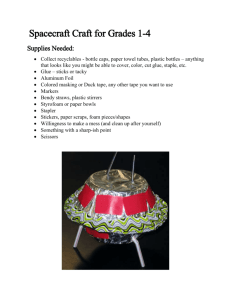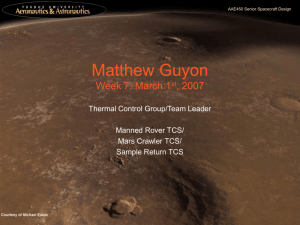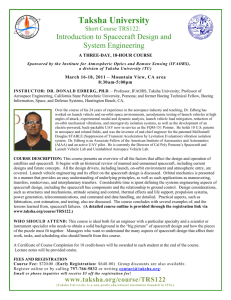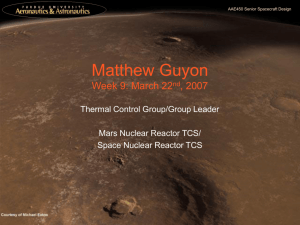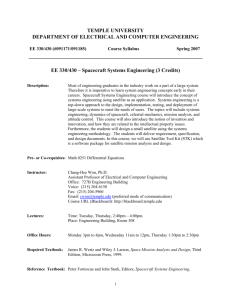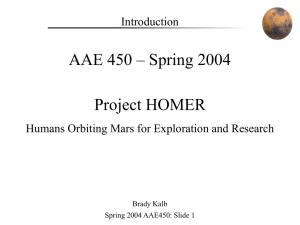Aero - Kumar - Entry Vehicle Analysis: Lifting Body
advertisement
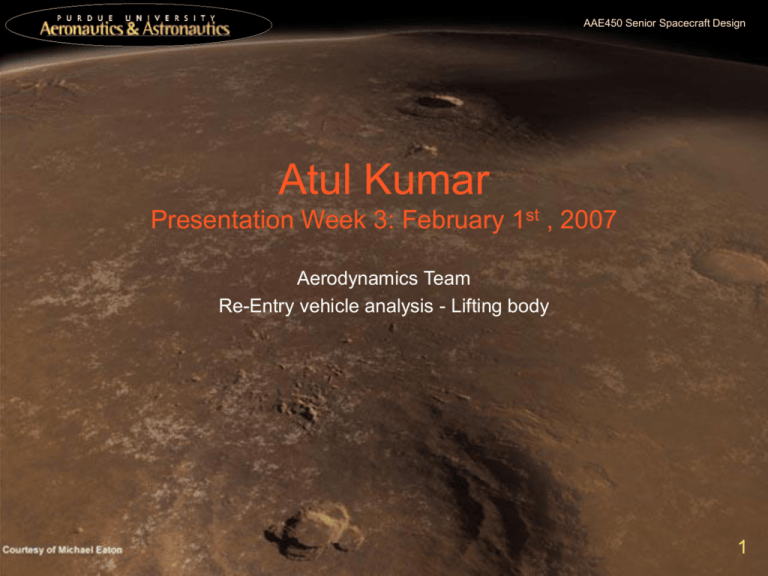
AAE450 Senior Spacecraft Design Atul Kumar Presentation Week 3: February 1st , 2007 Aerodynamics Team Re-Entry vehicle analysis - Lifting body 1 AAE450 Senior Spacecraft Design Mass calculations Mass components Payload Unit (M/T) 734.0506 Propellant 66.580 Structural mass w/o heat shield 42.169 Heat shield mass (underestimate) Total Mass ~ 6.3085 849.1081 Heat shield mass based on a rough estimate made by the Thermal team’s 20 kg/m^2 for the Mars Lander vehicle. Mass and Volume of the payload. For transfer from HMO to the surface of Mars at the end of 2nd synodic period. Carrying Habitat 2, Mars taxi 2, an ISPP and a taxi capsule AAE450 Senior Spacecraft Design Peak aerodynamic load (Gmax) Max g’s experienced by the vehicle at an assumed entry speed of 7620 m/sec or Mach~ 33 from a height of 10.8 km above the Martian surface. 7620 m/sec is the speed of the space shuttle at entry. g’s experienced by the vehicle versus flight path angle 2 AAE450 Senior Spacecraft Design Geometry of the vehicle 3-D drawing of the proposed reentry vehicle. Drawn by Atul Kumar Generalized geometry of a hypersonic vehicle. Figure based on book by Hankey, Wilbur L. Reentry Aerodynamics et al. ref 1 AAE450 Senior Spacecraft Design Backup slides mtotal / Cd S AAE450 Senior Spacecraft Design Plots L/D versus Angle of attack Ballistic coefficient, β versus L/D ratio The two most aerodynamic characteristics, L/D ratio and the Ballistic coefficient define the undershoot boundary. Once the entry vehicle design requirements and crew load tolerances are computed, the entry flight path angle needed to limit undershoot can be computed. The undershoot boundary defines the constraints for heat load or g-limit. AAE450 Senior Spacecraft Design Calculations Gmax Ve2 sin( e ) /(2eg e H s ) e - flight path angle e - 2.71828 ge- Gravitational constant, 9.81m/sec^2 Hs- scale height of Mars atmosphere, 10.8km e Ve- entry speed taken 7620 m/sec Gmax = 7620^2*sin(10*pi/180)/(2*2.71828*9.81*10800) = 17.5050 m/sec^2 mtotal /(Cd S ) Mtotal – total mass of the vehicle Cd – coefficient of drag S – Reference area AAE450 Senior Spacecraft Design Plots Variation of temperature, pressure and density in Mars atmosphere with altitude 236.8 236.6 1000 0.02 900 0.018 800 0.016 236.4 236 Density, kg/m 3 Pressure, Pa Temperature, K 236.2 700 600 0.014 0.012 235.8 500 0.01 400 0.008 235.6 235.4 235.2 0 2000 4000 6000 8000 10000 12000 Altitude, m 300 0 2000 4000 6000 8000 10000 12000 Altitude, m 0.006 0 2000 4000 6000 8000 10000 12000 Altitude, m MARS Atmosphere Variation of Temperature, Pressure and Density of the Mars atmosphere with altitude AAE450 Senior Spacecraft Design Computer codes Code to compute the properties of Martian Atmosphere. Pressure, temperature, density and acceleration due to gravity as functions of height. AAE450 Senior Spacecraft Design Plots Well sustained crew can withstand a maximum deceleration of 12 g’s for a short period of time. And for a deconditioned crew this limit is between 3.5- 5g’s. - Too little deceleration can cause the vehicle to skip off the planet’s atmosphere like a bouncing rock and too much deceleration can cause excessive heating and can damage the vehicle and jeopardize the crew’s safety. Deceleration of the vehicle versus flight path angle AAE450 Senior Spacecraft Design Plots 0.4 0.55 0.35 0.5 0.45 d 0.25 Coefficient of drag, C l Coefficient of lift, C 0.3 0.2 0.15 0.1 0.05 0.35 0.3 0.25 0.2 0.15 0 -0.05 0.4 0.1 0 10 20 30 40 Angle of Attack, AOA (deg) 50 0.05 0 10 20 30 40 Angle of Attack, AOA (deg) 50 Plots for variations of coefficients of drag and lift with angle of attack AAE450 Senior Spacecraft Design Equation used to compute Cl and Cd Equations taken from the book Re-entry Aerodynamics, ref 1 AAE450 Senior Spacecraft Design Contd AAE450 Senior Spacecraft Design Drawings Different types of aerodynamic Maneuvers Figure based on book by Larsonand Pranke et al. ref 2 AAE450 Senior Spacecraft Design Drawings Entry Corridor Figure based on book by Larsonand Pranke et al. ref 2 AAE450 Senior Spacecraft Design References • Hankey, Wilbur L., Re-Entry Aerodynamics Chapter-3 Hypersonic Aerodynamics, pgs 70, 71, 72 & 73 • • Larson, Wiley J., Pranke Linda K. Human Spaceflight Mission Analysis and Design, pgs 279, 314-315 Schneider, Steven P Methods for analysis of preliminary Spacecraft Designs, September 19th 2005 • Lessing, Henry C. Coate, Robert E., A Simple Atmosphere Reentry Guidance Scheme For Return From The Manned Mars Mission • Griffin, Michael D. , French, James R. Space Vehicle Design, Chapter 6- Atmospheric entry, section -1, pg 231 • Anderson, John D., Jr. Fundamentals of Aerodynamics, chapter 14. • Technical overview of the space shuttle orbiter http://www.columbiassacrifice.com/&0_shttlovrvw.htm • Mars Fact sheet www.spds.nasa.gov/planetary/factsheet/marsfact.html+surface+density+of+mars&hl=en&gl=us&ct=clnk&cd= • NSTS 1988 News Reference manual http://science.ksc.nasa.gov/shuttle/technology/sts-newsref/stsref-toc.html • Wikipedia, www.wikipedia.org 7
